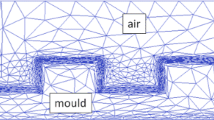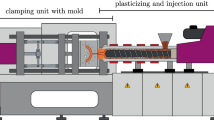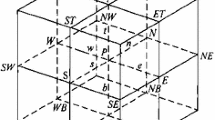Abstract
This paper suggests an original numerical investigation through a two-phase filling-stage model of microinjection moulding (μIM) of thermoplastics. An unsymmetrical stepped-part decreasing thickness was considered to perform our modelling attempts. The transient equations of mass, momentum, energy conservation, and crystallization kinetics are solved simultaneously using the Finite Element Method (FEM). Flow front advancement is tracked through the Level-set method (LSM), employing the penalty approach to deal with the mass loss problems. The significant role of the interfacial thermal contact resistance (TCR) is introduced by the thermal joint resistances approach to predict the strenuous heat transfer phenomenon along the melt–mould interface, with the presence of gap conductance. The numerical code predicted the V-shapes of the flow Fountain effect and the distinguishing flow marks due to the trapped air between the melt front and the mould. The high accuracy of the thermal joint interfacial heat transfer (htc) model and the consideration of the micro-scale features are necessary for capturing such relevant details. Model validation was performed using simulation of predicted spherulite diameters, shear rates, and layer thickness measurements. Aspects of the present work are beyond the capability of the current commercial software.













Similar content being viewed by others
Availability of data and material
The data that support the findings of this study are available from the corresponding author upon reasonable request.
References
Han SR, Cho JR, Beak SK, Hong JA, Lee YS (2017) Numerical and experimental studies of injection compression molding process for thick plastic gas valve stem. Int J Adv Manuf Technol 89(1–4):651–660. https://doi.org/10.1007/s00170-016-9139-6
Xie L, Shen L, Jiang B (2011) Modelling and simulation for micro injection molding process. In Minin O (ed) Computational Fluid Dynamics Technologies and Applications, IntechOpen, pp 317–332. https://doi.org/10.5772/16283. Available from: https://www.intechopen.com/chapters/16394
Shen Y-K, Chang C-Y, Shen Y-S, Hsu S-C, Wu M-W (2008) Analysis for microstructure of microlens arrays on micro-injection molding by numerical simulation. Int Commun Heat Mass Transfer 35(6):723–727. https://doi.org/10.1016/j.icheatmasstransfer.2008.01.013
Nakhoul R, Laure P, Silva L, Vincent M (2018) A multiphase Eulerian approach for modelling the polymer injection into a textured mould. Int J Mater Form 11(1):53–66. https://doi.org/10.1007/s12289-016-1328-1
Rytka C, Lungershausen J, Kristiansen PM, Neyer A (2016) 3D filling simulation of micro- and nanostructures in comparison to iso- and variothermal injection moulding trials. J Micromech Microeng 26(6):065018. https://doi.org/10.1088/0960-1317/26/6/065018
La M, Lee JG, Park SJ (2018) Numerical and experimental investigation of plastic injection molding of micro-engineered surfaces. Polym Eng Sci 58(S1):E73–E81. https://doi.org/10.1002/pen.24652
Sardo L, Daldoul W, Vincent M, Toulorge T (2019) Simulations of heat transfer in thermoplastic injection molds manufactured by additive techniques. Int Polym Proc 34(1):37–46. https://doi.org/10.3139/217.3594
Cooper MG, Mikict BB, Yovanovich MM (1969) Thermal contact conductance. Int J Heat Mass Trans 12:279–300. http://www.mhtl.uwaterloo.ca/pdf_papers/mhtl69-2.pdf
Dawson A, Rides M, Allen CRG, Urquhart JM (2008) Polymer–mould interface heat transfer coefficient measurements for polymer processing. Polym Testing 27(5):555–565. https://doi.org/10.1016/j.polymertesting.2008.02.007
Hamasaiid A, Dargusch MS, Loulou T, Dour G (2011) A predictive model for the thermal contact resistance at liquid–solid interfaces: Analytical developments and validation. Int J Therm Sci 50(8):1445–1459. https://doi.org/10.1016/j.ijthermalsci.2011.02.016
Fu J, Ma YA (2019) A method to predict early-ejected plastic part air-cooling behavior towards quality mold design and less molding cycle time. Robot Comput Integr Manuf 56:66–74. https://doi.org/10.1016/j.rcim.2018.08.004
Delaunay D, Le Bot P, Fulchiron R, Luye JF, Regnier G (2000) Nature of contact between polymer and mold in injection molding. Part I: Influence of a non-perfect thermal contact. Polym Eng Sci 40(7):1682–1691. https://doi.org/10.1002/pen.11300
Le Goff R, Poutot G, Delaunay D, Fulchiron R, Koscher E (2005) Study and modeling of heat transfer during the solidification of semi-crystalline polymers. Int J Heat Mass Transf 48(25–26):5417–5430. https://doi.org/10.1016/j.ijheatmasstransfer.2005.06.015
Yu L, Lee LJ, Koelling KW (2004) Flow and heat transfer simulation of injection molding with microstructures. Polym Eng Sci 44(10):1866–1876. https://doi.org/10.1002/pen.20188
Somé SC, Delaunay D, Faraj J, Bailleul J-L, Boyard N, Quilliet S (2015) Modeling of the thermal contact resistance time evolution at polymer–mold interface during injection molding: Effect of polymers’ solidification. Appl Therm Eng 84:150–157. https://doi.org/10.1016/j.applthermaleng.2015.03.037
Hong S, Kang J, Yoon K (2015) Correlation between thermal contact resistance and filling behavior of a polymer melt into multi-scale cavities in injection molding. Int J Heat Mass Transf 87:222–236. https://doi.org/10.1016/j.ijheatmasstransfer.2015.03.061
Babenko M, Sweeney J, Petkov P, Lacan F, Bigot S, Whiteside B (2018) Evaluation of heat transfer at the cavity-polymer interface in microinjection moulding based on experimental and simulation study. Appl Therm Eng 130:865–876. https://doi.org/10.1016/j.applthermaleng.2017.11.022
Zhu L-Y, Wu W-Q, Jiang L, Jiang B-Y (2019) Research on influencing factors of the thermal contact resistance in thin-wall injection molding. IPP 34(1):2–8. https://doi.org/10.3139/217.3617
Weng C, Li J, Lai J, Liu J, Wang H (2020) Investigation of interface thermal resistance between polymer and mold insert in micro-injection molding by non-equilibrium molecular dynamics. Polymers 12(10):2409. https://doi.org/10.3390/polym12102409
Aalilija A, Gandin C-A, Hachem E (2021) A simple and efficient numerical model for thermal contact resistance based on diffuse interface immersed boundary method. Int J Therm Sci 166:106817. https://doi.org/10.1016/j.ijthermalsci.2020.106817
Whiteside BR, Martyn MT, Coates PD, Greenway G, Allen P, Hornsby P (2004) Micromoulding: Process measurements, product morphology and properties. Plast, Rubber Compos 33(1):11–17. https://doi.org/10.1179/146580104225018346
Zdanski PSB, Vaz M (2006) Polymer melt flow in plane channels: Effects of the viscous dissipation and axial heat conduction. Num Heat Trans Part A: Appl 49(2):159–174. https://doi.org/10.1080/10407780500302059
Pantani R, Coccorullo I, Speranza V, Titomanlio G (2005) Modeling of morphology evolution in the injection molding process of thermoplastic polymers. Prog Polym Sci 30(12):1185–1222. https://doi.org/10.1016/j.progpolymsci.2005.09.001
Boutaous M, Otmani RE, Benhadid H (2013) Conservative level set method without re-initialization process: Application to multiphase flows. Int J Model Simul 33(3):162–172. https://doi.org/10.2316/Journal.205.2013.3.205-5814
Schneider W, Köppel A, Berger J (1988) Non-isothermal crystallization, crystallization of polymers. Int Polym Proc 2(3–4):151–154. https://doi.org/10.3139/217.880150
van Krevelen DW, te Nijenhuis K (2009) Properties of polymers: Their correlation with chemical structure: Their numerical estimation and prediction from additive group contributions. Elsevier Science, Amsterdam. https://doi.org/10.1016/B978-0-08-054819-7.00033-9
Cao W, Kong L, Li Q, Ying J, Shen C (2011) Model and simulation for melt flow in micro-injection molding based on the PTT model. Modelling Simul Mater Sci Eng 19(8):085003. https://doi.org/10.1088/0965-0393/19/8/085003
Kim S-W, Turng L-S (2004) Developments of three-dimensional computer-aided engineering simulation for injection moulding. Modelling Simul Mater Sci Eng 12(3):S151–S173. https://doi.org/10.1088/0965-0393/12/3/S07
Mu Y, Zhao G, Chen A, Wu X (2012) Numerical investigation of the thermally and flow induced crystallization behavior of semi-crystalline polymers by using finite element–finite difference method. Comput Chem Eng 46:190–204. https://doi.org/10.1016/j.compchemeng.2012.06.026
Yovanovich MM (1981) New contact and gap conductance correlations for conforming rough surfaces. Proc of AIAA 16th Thermophysics Conference, Palo Alto, CA (Paper No. 81–1164). https://doi.org/10.2514/6.1981-1164
Yovanovich MM, Culham JR, Teerstra P (1997) Calculating interface resistance. Electron Cool 3(24):1–9. http://www.mhtl.uwaterloo.ca/pdf_papers/mhtl97-4.pdf
Haagh GAAV, Zuidema H, van de Vosse FN, Peters GWM, Meijer HEH (1997) Towards a 3-D finite element model for the gas-assisted injection moulding process. IPP 12(3):207–215. https://doi.org/10.3139/217.970207
Benayad A, El Otmani R, El Hakimi A, Boutaous M, Touache A, Musa KR et al (2021) Experimental investigation and numerical simulation of the microinjection molding process through an expanding flow configuration. Polym Adv Technol 32(4):1690–1711. https://doi.org/10.1002/pat.5206
El Otmani R, Zinet M, Boutaous M, Benhadid H (2011) Numerical simulation and thermal analysis of the filling stage in the injection molding process: Role of the mold-polymer interface. J Appl Polym Sci 121(3):1579–1592. https://doi.org/10.1002/app.33699
Anass B, M’hamed B, Rabie EO, Abdelhadi EH, Abdelhamid T, Musa KR et al (2020) Simulation of crystallization evolution of Polyoxymethylene during microinjection molding cycle. Polym Adv Technol 31(4):838–852. https://doi.org/10.1002/pat.4819
Chu J-S, Kamal MR, Derdouri A, Hrymak A (2012) Morphology development in the gate region of microinjection-molded thermoplastics. Polym Eng Sci 52(4):787–794. https://doi.org/10.1002/pen.22143
Yoshii M, Kuramoto H, Kato K (1993) Experimental study of transcription of smooth surfaces in injection molding. Polym Eng Sci 33(19):1251–1260. https://doi.org/10.1002/pen.760331905
Tredoux L, Satoh I, Kurosaki Y (1999) Investigation of wave-like flow marks in injection molding: Flow visualization and micro-geometry. Polym Eng Sci 39(11):2233–2241. https://doi.org/10.1002/pen.11611
Tredoux L, Satoh I, Kurosaki Y (2000) Investigation of wavelike flow marks in injection molding: a new hypothesis for the generation mechanism. Polym Eng Sci 40(10):2161–2174. https://doi.org/10.1002/pen.11348
Kamal MR, El Otmani R, Derdouri A, Chu J-S (2017) Flow and thermal history effects on morphology and tensile behavior of Poly(oxymethylene) micro injection molded parts. IPP 32(5):590–605. https://doi.org/10.3139/217.3472
Zinet M, El Otmani R, Boutaous M, Chantrenne P (2010) Numerical modeling of non-isothermal polymer crystallization kinetics: Flow and thermal effects. Polym Eng Sci 50(10):2044–2059. https://doi.org/10.1002/pen.21733
Kamal MR, Chu J, Derdouri S, Hrymak A (2010) Morphology of microinjection moulded polyoxymethylene. Plast Rubber Compos 39(7):332–341. https://doi.org/10.1179/174328910X12691245470518
Author information
Authors and Affiliations
Corresponding author
Ethics declarations
Consent of participate
We are agreeing to participate.
Consent for publication
We are agreeing to publish this work.
Conflicts of interest
The authors declare that they have no conflict of interest.
Additional information
Publisher's Note
Springer Nature remains neutral with regard to jurisdictional claims in published maps and institutional affiliations.
Rights and permissions
About this article
Cite this article
Ben Ayad, A., El Otmani, R., El Hakimi, A. et al. Numerical simulation of flow and thermal behaviour of polymer under microinjection moulding process: role of the thermal joint model at the mould–melt interface. Int J Adv Manuf Technol 119, 7429–7447 (2022). https://doi.org/10.1007/s00170-022-08682-7
Received:
Accepted:
Published:
Issue Date:
DOI: https://doi.org/10.1007/s00170-022-08682-7




